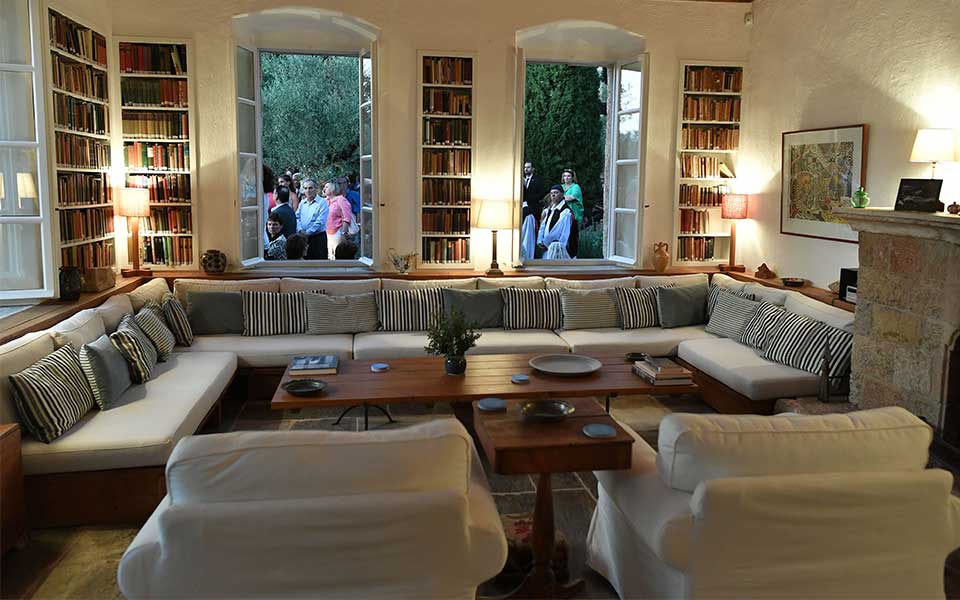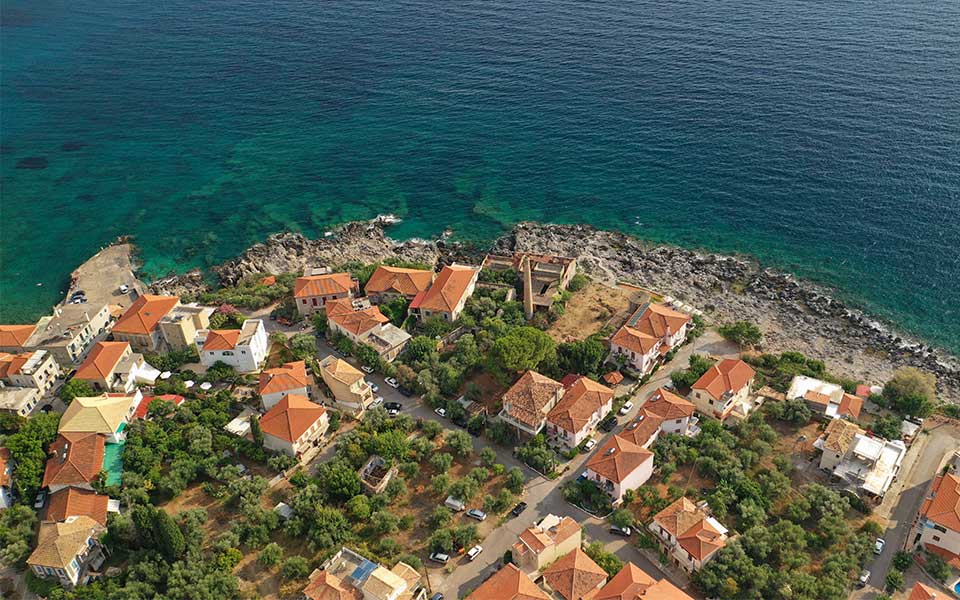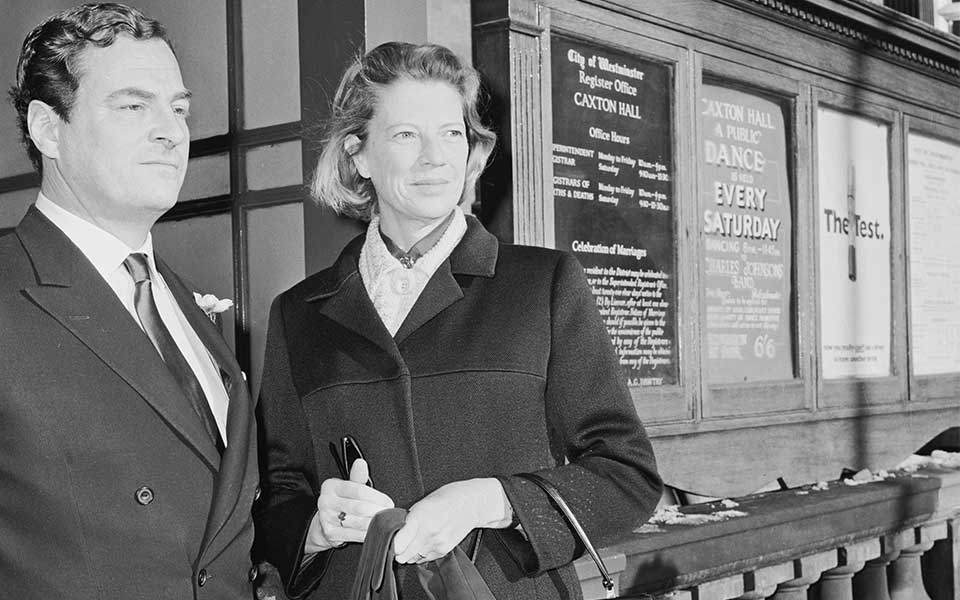One of the greatest Greek love stories of the 20th century actually stars… two English people. For Joan Eyres Monsell and Patrick Leigh Fermor, an enduring decades-long romance and a life-long love of Greece were magically entwined, and Greece loved them back.
A luminous individual born into a world of privilege, Joan was one of the most celebrated and adored women in her illustrious pre-war intellectual circle. Her golden-haired, blue-eyed willowy beauty (she was nearly six feet tall) may have served many as the initial attraction, but her other gifts soon outshone that. Joan had a sparkling intelligence that would make her an inspiration and muse to many, and a kind character. A natural reticence – she was never a woman to seek attention – only added to her charms. She was much admired.
Her marriage to John Reynor – an event bewailed by other would-be suitors – on the eve of WWII did not survive to the war’s end. At first, Joan served the war effort as a photographer, compiling a visual record of the ruins of London after the Blitz. (She had contributed images to Architectural Review and Horizon before the war, and would do so afterwards as well.) She then trained as a cipher clerk (encrypting and decrypting messages), seeking a posting abroad. She was dispatched first to Algiers, then Madrid. By Christmas of 1944, still officially Joan Reynor, she was in Cairo. So was Patrick Leigh Fermor; the attraction between them was immediate, the beginning of an intense romantic bond that would last through to her death six decades later.

© AP Photo/Thanassis Stavrakis
As for Patrick – “Paddy” to all who adored him, which was nearly everyone who knew him – “dashing” doesn’t really suffice; Leigh Fermor’s movie-star good looks were nothing compared to his valor. Twenty-nine years old when Joan met him at that Cairo party, he was already a war hero, having been an active member of the Cretan resistance in WWII and leading the team that kidnapped Heinrich Kreipe, a German general stationed on the island. Before that, he’d had over a decade’s worth of adventures, including walking across Europe – from Holland to Istanbul – when he was just 18. He matched Joan, who’d been an extremely unconventional debutante, in his individuality (described as “a dangerous mixture of sophistication and recklessness” by his housemaster at one of the boarding schools from which he was expelled) and his magnetic charm (his first serious romantic liaison was with a Romanian princess, one Balasha Cantacuzène; they lived together in an old watermill on the island of Poros).
The attraction between Patrick and Joan was immediate, but they wouldn’t marry until more than two decades later, in 1968. He did join her when she took a post at the British Embassy in Athens, but the couple would soon part ways for a while; there were, after all, war criminals for Patrick to pursue in Germany. Joan, meanwhile, had planned an expedition to Iraqi Kurdistan, going by train to Kirkuk and then continuing on horseback with local guides, recording the experience in both photographs and words. After this interlude of adventure, they were together again in Athens, with Joan at the Embassy, Paddy at the British Institute. This was a period in which several deep friendships were formed with others around them, including the painter Nikos Hadjikyriakos-Ghika, and – especially for Joan – the Nobel prize-winning poet George Seferis.

© AMNA/Nikitas Kotsiaris
So strong was the bond between Patrick and Joan – based not only on romantic love but perhaps even more substantially on a profound mutual regard – that it survived unscathed through both their other attractions and attachments over their many years together. “Separated in many ways, they retained the intimacy of a lasting love affair,” Ian Collins and Olivia Stewart wrote in “The Photographs of Joan Leigh Fermor, Artist and Lover,” adding that “They were united by a pact of liberty.” This pact ultimately allowed them to live their most fulfilling lives.
Greece was the catalyst for that fulfillment, for the realization of their spiritual and creative destinies. Paddy was already entirely at home in Greece. Joan was taken with the country and people at once, and the affection was mutual. Their experiences together in Greece were idyllic. There is, for instance, a scene in Episode 2 of the first season of the television series “The Durrells,” where the Durrell family are seated waist-deep in the sea around a table for a picnic. That really happened, just not with the Durrell family and not on Corfu. It was Joan, Patrick, and Xan Fielding, the man beside whom Paddy had fought in Crete. The three of them had sat down together at a seaside taverna in Kalamata, and spontaneously decided to seek refuge from the heat, carrying their table and chairs into the sea. A full account, including the complicity of the waiters and the careful approach of fishermen in their boats to share the decanters of retsina that onlookers were sending to the table, can be found in Patrick Leigh Fermor’s book “Mani: Travels in the Southern Peloponnese.”
Their journeys throughout the country, connecting with the land and the people they encountered, became their art. After “Mani: Travels in the Southern Peloponnese” (1958), Paddy wrote “Roumeli: Travels in Northern Greece (1966),” and Joan accompanied him on many of the adventures. The books, apart from being superbly observed accounts of people, land, and culture, are marked by a profound love for Greece that shines through in every description. While Patrick shared his impressions through words, Joan captured hers with the Roleiflex that was seemingly always hanging around her neck. Some of those photos appear in Patrick’s books.

© Shutterstock
A defining factor in their artistic output is a generosity of spirit and a deep respect and affection for Greece and everyone they encountered. Joan’s photographs are among the finest ever taken of Greece, capturing the majesty of landscape. Her photographs of archaeological sites trade that sense of monumentality that characterize earlier images (such as the works of famed Greek photographer Nelly’s) for depictions that are more approachable and personally revealing. Her images of people are captured with a sense of immediacy and intimacy, while still respecting the dignity of her subjects. Her own humility and kindness is surely to thank for this, but her camera deserves credit, too; the Roleiflex can take photos from waist height; the fact that photographer and subject could lock eyes changed the dynamic of the pose, creating a sense of connection and putting her subjects at greater ease. Another unusual feature of the Roleiflex is the entirely square 6×6 negative it produces; in “The Photographs of Joan Leigh Fermor,” Robert McCabe, another important photographer of Greece, praises her mastery in using those unusual dimensions to compositional advantage: “It would be impossible to crop most of her work into a 35mm frame. She composed brilliantly in a square.”
Joan and Patrick first saw the village of Kardamyli in Mani in the 1950s. The austere beauty of the landscape seemed a natural fit for their characters; they were utterly smitten. In 1964, they began construction on what eventually became a magnificent home, on a cliff between two coves. Joan was able to fund their shared dream, spending her personal fortune and even selling her jewelry to finance the dream. Paddy contributed his soul and his sweat, designing the Kardamyli house with an integrity that honored the thick-walled regional vernacular architecture of Mani. He labored alongside the builders as they worked magic with local stone. He became a ‟koumbaros,” or best man, to one of them, the master mason Nikos Kolokontronis. Paddy and Joan slept on-site in a tent; by night, he’d read Vitruvius and Palladio for inspiration.
Over time, Kardamyli became a gathering place for the era’s most interesting artists and thinkers, both Greek and international. Nikos and Barbara Hadjikyriakos-Ghika were frequent visitors, as was the painter John Craxton. John Betjeman, long a devoted friend of Joan and soon to be made poet laureate of Britain, visited, too. Beautifully quoted in “The Photographs of Joan Leigh Fermor, Artist and Lover” is an excerpt of a letter he wrote to Patrick in 1969, capturing the splendor and simplicity of the Leigh Fermors’ world: “What a wonderful life you and Joanie have had, and how wisely and well you have spent it, where the Orthodox saints look down with olive-shaped eyes from the walls of the basilica and the goats leap from crag to crag and the olives are silvery….”
They would enjoy that wonderful, creative life together for several decades more.












